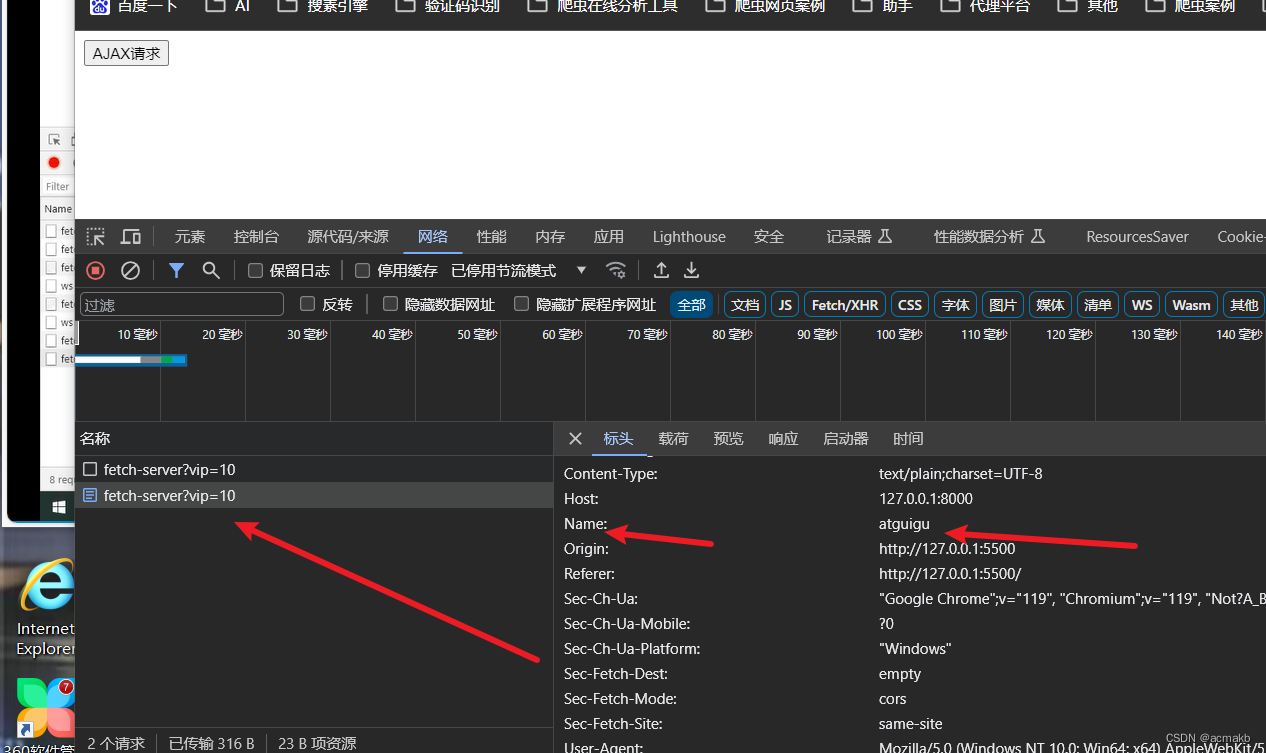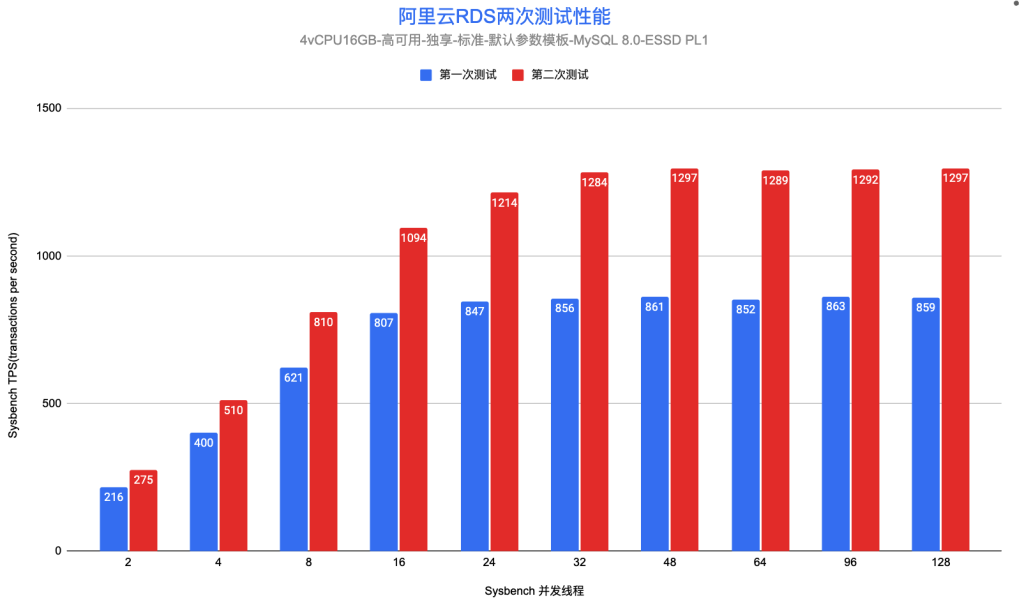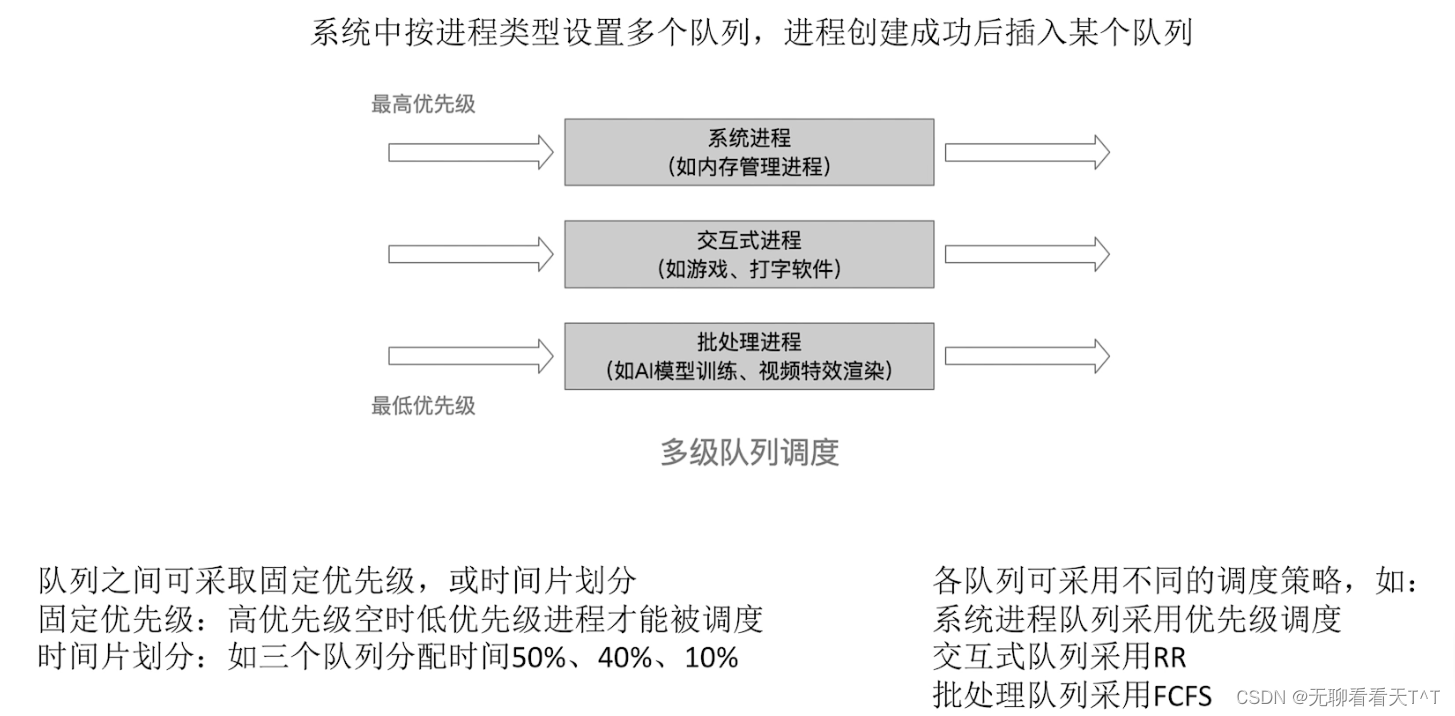Ajax学习
简介:
Ajax 代表异步 JavaScript 和 XML(Asynchronous JavaScript and XML)的缩写。它指的是一种在网页开发中使用的技术,通过在后台与服务器进行数据交换,实现页面内容的更新,而无需刷新整个页面。Ajax 技术可以使网页更加动态和交互性,提供更好的用户体验。
场景:
- 页面懒加载
- 登录注册相关提示
- 鼠标移上去才加载
XML:
XML (eXtensible Markup Language) 是一种用于描述数据的标记语言。它被设计用于传输和存储数据,同时具有跨平台和跨应用程序的特性。XML 使用标记来标识和组织数据,类似于 HTML,但不同于 HTML,XML 的目标是描述数据,传输数据而不是展示数据。
<student>
<name>孙悟空</name>
<age>18</age>
<gender>男</gender>
</student>
<person><name>John Doe</name><age>30</age><email>john.doe@example.com</email>
</person>
JSON:
JSON (JavaScript Object Notation) 是一种轻量级的数据交换格式。它基于 JavaScript 的语法,但已成为一种独立于编程语言的通用数据格式。JSON 使用易于阅读和编写的文本格式,用于表示结构化的数据。
{"name":"孙悟空","age":18,"gender":"男"}
{"name": "John Doe","age": 30,"email": "john.doe@example.com","hobbies": ["reading", "traveling", "photography"],"address": {"street": "123 Main St","city": "Exampleville","country": "USA"}
}
服务端框架:
因为Ajax的学习需要与服务器端进行交互,为了学习方便,我们采用express框架作为服务器端。
官网:Express/Node 入门 - 学习 Web 开发 | MDN (mozilla.org)
环境安装:
npm init --yes
npm i express //相当于npm install express
express的基本使用
//1. 引入express
const express = require('express');
//2. 创建应用对象
const app = express();//3. 创建路由规则
// request 是对请求 response是响应
// 当访问跟路由的时候向reponse发送数据
app.get('/', (request, response)=>{//设置响应数据response.send('HELLO EXPRESS');
});//4. 监听端口启动服务
app.listen(8000, ()=>{console.log("服务已经启动, 8000 端口监听中....");
});


原生框架:
get请求:
<!DOCTYPE html>
<html lang="en">
<head><meta charset="UTF-8"><meta name="viewport" content="width=device-width, initial-scale=1.0"><title>AJAX GET 请求</title><style>#result{width:200px;height:100px;border:solid 1px #90b;}</style>
</head>
<body><button>点击发送请求</button><div id="result"></div><script>//获取button元素const btn = document.getElementsByTagName('button')[0];const result = document.getElementById("result");// 对按钮绑定点击事件 btn.onclick = function(){//1. 创建对象const xhr = new XMLHttpRequest();//2. 初始化 设置请求方法和 urlxhr.open('GET', 'http://127.0.0.1:8000/server?a=100&b=200&c=300');//3. 发送xhr.send();//4. 事件绑定 处理服务端返回的结果xhr.onreadystatechange = function(){//判断 (服务端返回了所有的结果)if(xhr.readyState === 4){// 2xx 成功if(xhr.status >= 200 && xhr.status < 300){//响应 console.log(xhr.status);//状态码 200console.log(xhr.statusText);//状态字符串 OK?console.log(xhr.getAllResponseHeaders());//所有响应头console.log(xhr.response);//响应体//设置 result 的文本result.innerHTML = xhr.response;}else{}}}}</script>
</body>
</html>
后台服务器,服务器是用express框架搭建起来的本地服务器。
//1. 引入express
const express = require('express');//2. 创建应用对象
const app = express();
app.get('/', (request, response) => {//设置响应response.send('HELLO EXPRESS');});
//3. 创建路由规则
// app.get 是get请求
app.get('/server', (request, response) => {//设置响应头 设置允许跨域response.setHeader('Access-Control-Allow-Origin', '*');//设置响应体response.send('HELLO AJAX - 2');
});我们看一下点击后的结果:

post请求:
<!DOCTYPE html>
<html lang="en"><head><meta charset="UTF-8"><meta name="viewport" content="width=device-width, initial-scale=1.0"><title>AJAX POST 请求</title><style>#result {width: 200px;height: 100px;border: solid 1px #bfa;}</style>
</head><body><div id="result"></div><script>//获取元素对象const result = document.getElementById("result");//绑定事件 对普通元素的绑定 //DOM2的方式 mouseover 鼠标移上去 result.addEventListener("mouseover", function () {//1. 创建对象const xhr = new XMLHttpRequest();//2. 初始化 设置类型与 URLxhr.open('POST', 'http://127.0.0.1:8000/server');//3. 发送xhr.send('a=100&b=200&c=300');//4. 事件绑定xhr.onreadystatechange = function () {//判断if (xhr.readyState === 4) {if (xhr.status >= 200 && xhr.status < 300) {//处理服务端返回的结果result.innerHTML = xhr.response;}}}});</script>
</body></html>
//1. 引入express
const express = require('express');//2. 创建应用对象
const app = express();
app.get('/', (request, response) => {//设置响应response.send('HELLO EXPRESS');
});app.post('/server', (request, response) => {//设置响应头 设置允许跨域response.setHeader('Access-Control-Allow-Origin', '*');//设置响应体response.send('HELLO AJAX - 2 post');
});
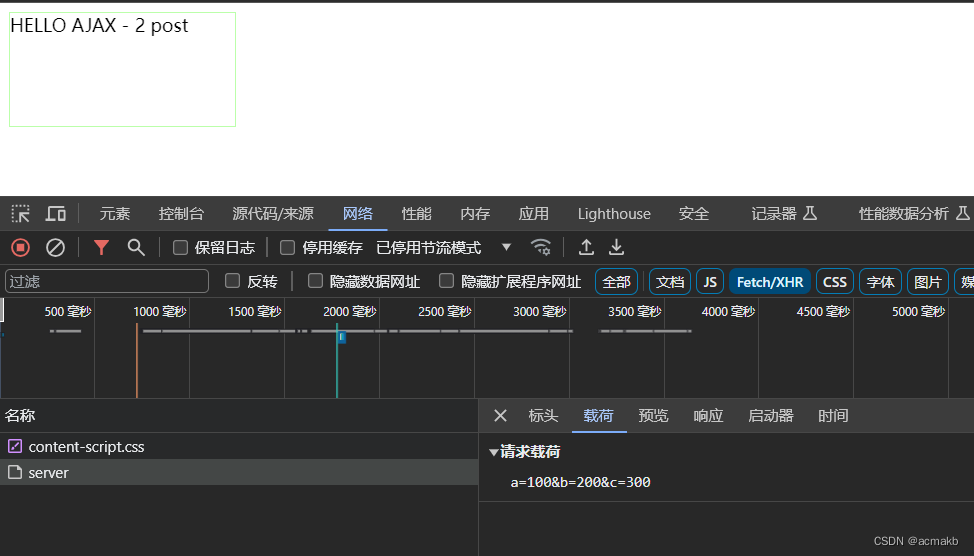
请求头:
下面我们看下如何设置请求头参数:
<!DOCTYPE html>
<html lang="en"><head><meta charset="UTF-8"><meta name="viewport" content="width=device-width, initial-scale=1.0"><title>AJAX POST 请求</title><style>#result {width: 200px;height: 100px;border: solid 1px #bfa;}</style>
</head><body><div id="result"></div><script>const result = document.getElementById("result");result.addEventListener("mouseover", function () {//1. 创建对象const xhr = new XMLHttpRequest();//2. 初始化 设置类型与 URLxhr.open('POST', 'http://127.0.0.1:8000/server');//设置请求头xhr.setRequestHeader('Content-Type', 'application/x-www-form-urlencoded');//Content-Type 设置请求体类型 //application/x-www-form-urlencoded 参数查询字符串的类型//3. 发送xhr.send('a=100&b=200&c=300');xhr.onreadystatechange = function () {//判断if (xhr.readyState === 4) {if (xhr.status >= 200 && xhr.status < 300) {//处理服务端返回的结果result.innerHTML = xhr.response;}}}});</script>
</body></html>
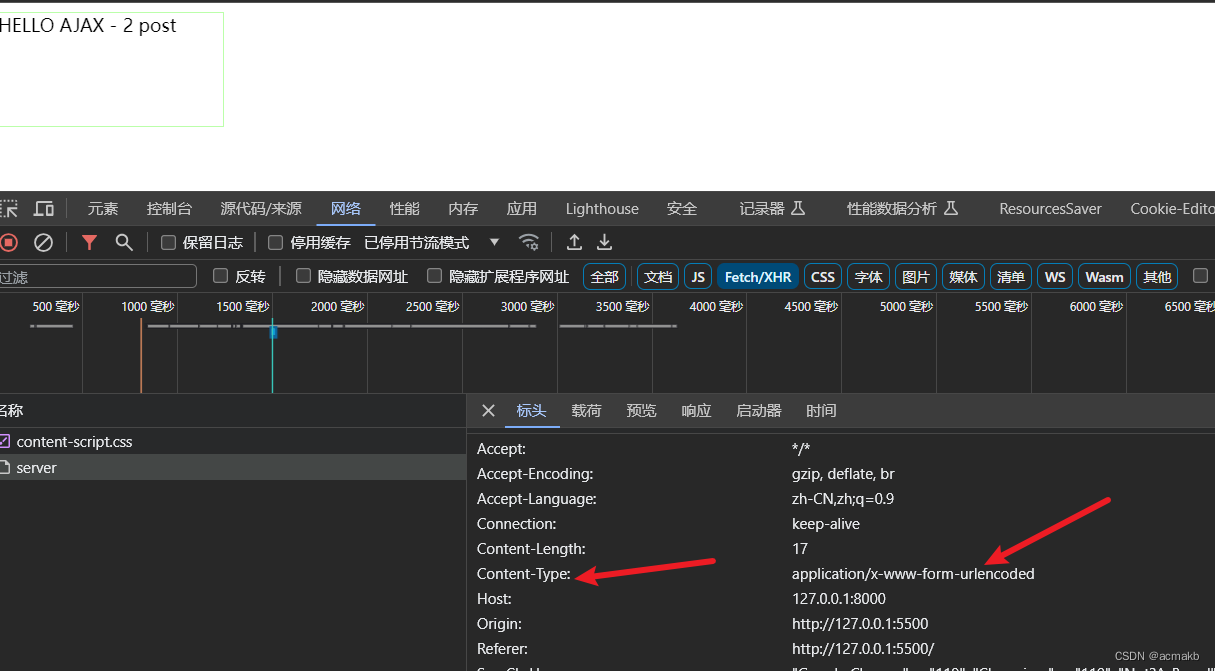
自定义请求头:
<!DOCTYPE html>
<html lang="en"><head><meta charset="UTF-8"><meta name="viewport" content="width=device-width, initial-scale=1.0"><title>AJAX POST 请求</title><style>#result {width: 200px;height: 100px;border: solid 1px #bfa;}</style>
</head><body><div id="result"></div><script>//获取元素对象const result = document.getElementById("result");result.addEventListener("mouseover", function () {const xhr = new XMLHttpRequest();xhr.open('POST', 'http://127.0.0.1:8000/server');xhr.setRequestHeader('Content-Type', 'application/x-www-form-urlencoded');xhr.setRequestHeader('name', 'demo');//3. 发送xhr.send('a=100&b=200&c=300');// xhr.send();//4. 事件绑定xhr.onreadystatechange = function () {//判断if (xhr.readyState === 4) {if (xhr.status >= 200 && xhr.status < 300) {//处理服务端返回的结果result.innerHTML = xhr.response;}}}});</script>
</body></html>
//可以接收任意类型的请求
app.all('/server', (request, response) => {//设置响应头 设置允许跨域response.setHeader('Access-Control-Allow-Origin', '*');//响应头response.setHeader('Access-Control-Allow-Headers', '*');//设置响应体response.send('HELLO AJAX POST');
});
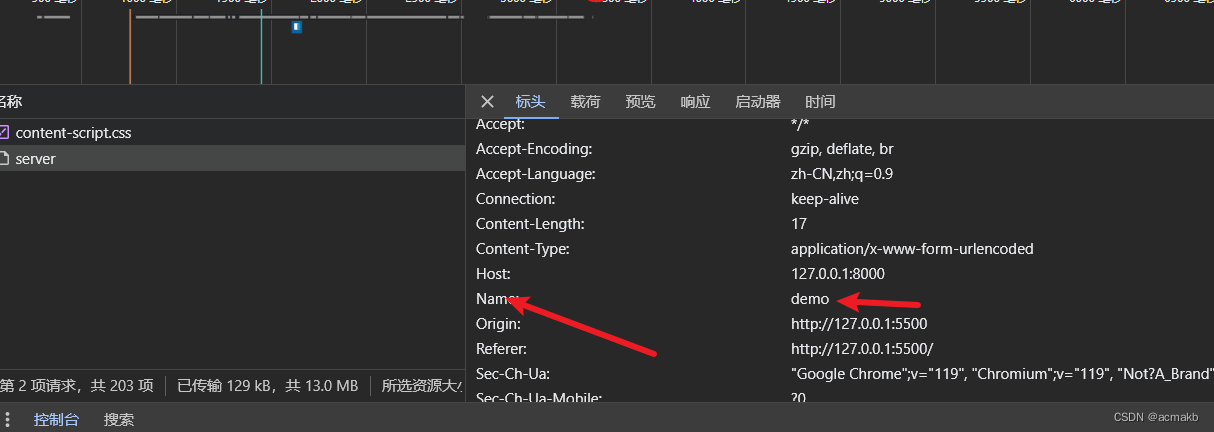
JSON:
有一个问题,在ajax中后台只能给前台传递字符串,但是json对象是一个键值对形式的对象,我们不能传递对象,所以在服务器端需要使用 JSON.stringify() 将json对象专户为json字符串,这样就可以发送了。同样的我们前端对后端传递过来的json字符串,需要重新转化为json对象,调用JSON.parse() 这个方法。
<!DOCTYPE html>
<html lang="en">
<head><meta charset="UTF-8"><meta name="viewport" content="width=device-width, initial-scale=1.0"><title>JSON响应</title><style>#result{width:200px;height:100px;border:solid 1px #89b;}</style>
</head>
<body><div id="result"></div><script>const result = document.getElementById('result');//绑定键盘按下事件window.onkeydown = function(){const xhr = new XMLHttpRequest();xhr.responseType = 'json'; //自动处理xhr.open('GET','http://127.0.0.1:8000/json-server');xhr.send();xhr.onreadystatechange = function(){if(xhr.readyState === 4){if(xhr.status >= 200 && xhr.status < 300){// 1. 手动对数据转化// let data = JSON.parse(xhr.response);// result.innerHTML = data.name;// 2. 自动转换 result.innerHTML = xhr.response.name;}}}}</script>
</body>
</html>
app.all('/json-server', (request, response) => {//设置响应头 设置允许跨域response.setHeader('Access-Control-Allow-Origin', '*');//响应头response.setHeader('Access-Control-Allow-Headers', '*');const data = {name: 'demo'};//对对象进行字符串转换let str = JSON.stringify(data);//设置响应体response.send(str);
});
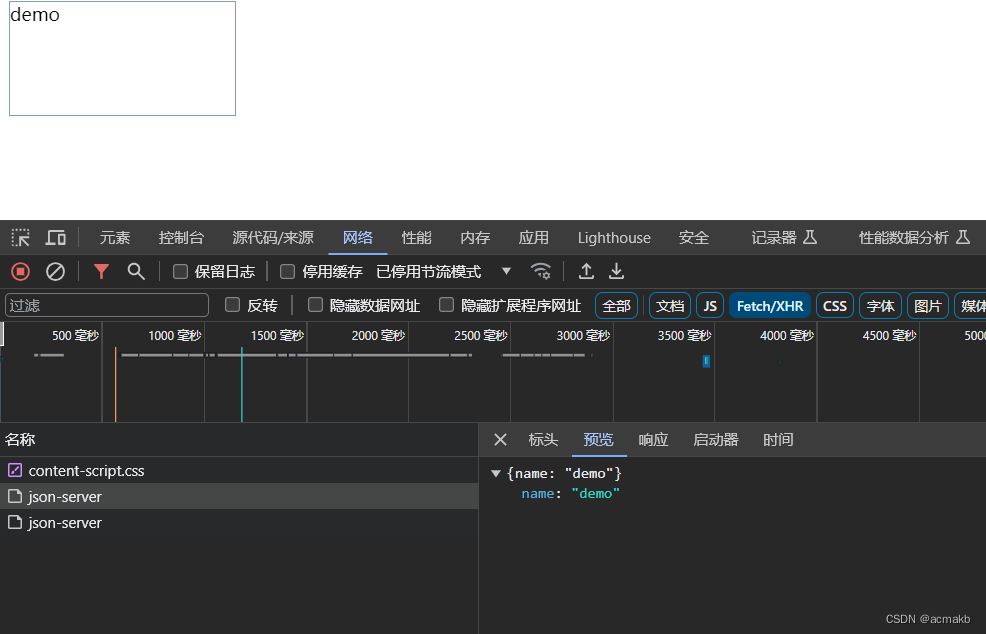
nodemon.cmd .\server.js
请求超时控制:
js中定时器的实现:
setTimeout(() => {response.send('延时响应');}, 1000) //1000代表1000毫秒 即1秒
<!DOCTYPE html>
<html lang="en">
<head><meta charset="UTF-8"><meta name="viewport" content="width=device-width, initial-scale=1.0"><title>请求超时与网络异常</title><style>#result{width:200px;height:100px;border:solid 1px #90b;}</style>
</head>
<body><button>点击发送请求</button><div id="result"></div><script>// 根据标签名 const btn = document.getElementsByTagName('button')[0];//根据css选择器 const result = document.querySelector('#result');btn.addEventListener('click', function(){const xhr = new XMLHttpRequest();//超时设置 2s 设置xhr.timeout = 2000;//超时回调xhr.ontimeout = function(){alert("网络异常, 请稍后重试!!");}//网络异常回调xhr.onerror = function(){alert("你的网络似乎出了一些问题!");}xhr.open("GET",'http://127.0.0.1:8000/delay');xhr.send();xhr.onreadystatechange = function(){if(xhr.readyState === 4){if(xhr.status >= 200 && xhr.status< 300){result.innerHTML = xhr.response;}}}})</script>
</body>
</html>
//延时响应
app.all('/delay', (request, response) => {response.setHeader('Access-Control-Allow-Origin', '*');response.setHeader('Access-Control-Allow-Headers', '*');setTimeout(() => {response.send('延时响应');}, 1000)
});
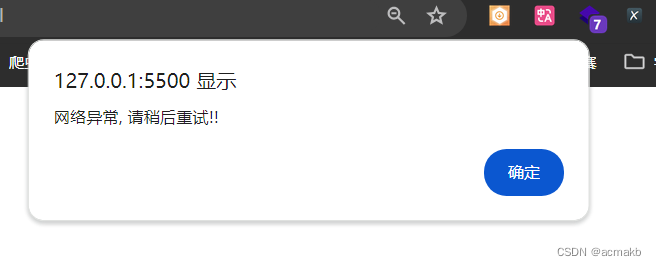

请求取消:
<!DOCTYPE html>
<html lang="en">
<head><meta charset="UTF-8"><meta name="viewport" content="width=device-width, initial-scale=1.0"><title>取消请求</title>
</head>
<body><button>点击发送</button><button>点击取消</button><script>//根据css选择器 选择所有按钮const btns = document.querySelectorAll('button');let x = null; //设置为全局的 btns[0].onclick = function(){x = new XMLHttpRequest();x.open("GET",'http://127.0.0.1:8000/delay');x.send();}// abortbtns[1].onclick = function(){x.abort();}</script>
</body>
</html>
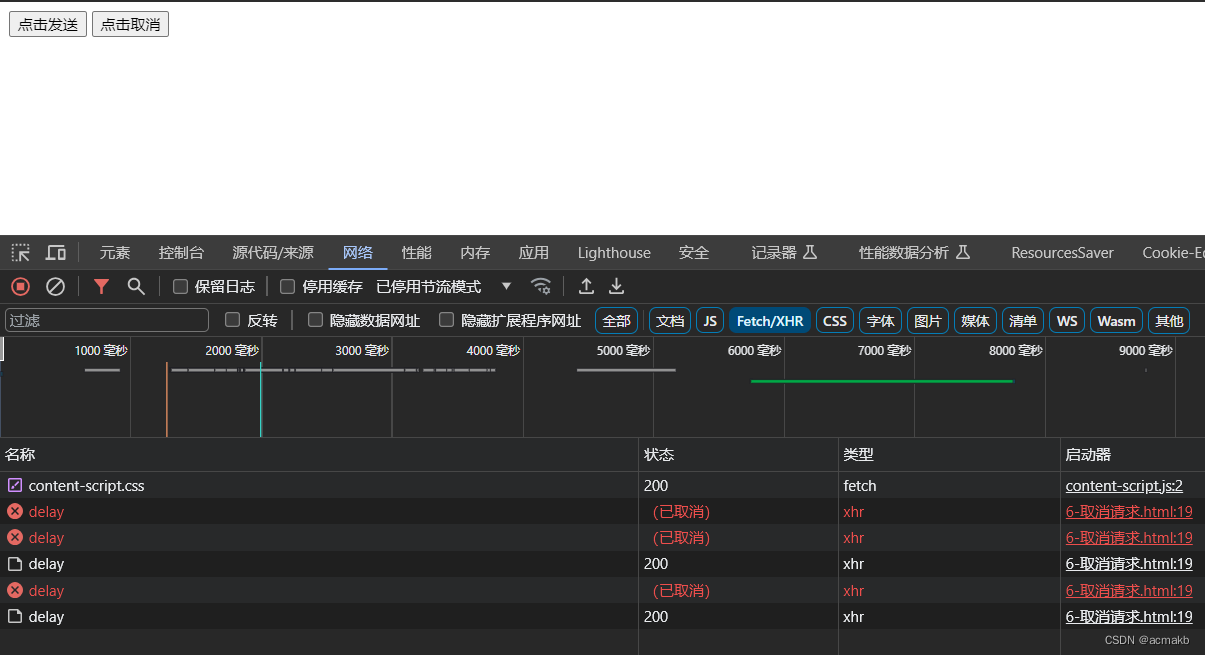
重复请求:
如果用户多次向服务端请求,到导致服务器压力很大,我们可以对多次请求只保留一次。如果点击多次,取出前面的请求,保留最后一次请求。
<!DOCTYPE html>
<html lang="en">
<head><meta charset="UTF-8"><meta name="viewport" content="width=device-width, initial-scale=1.0"><title>重复请求问题</title>
</head>
<body><button>点击发送</button><script>//获取元素对象const btns = document.querySelectorAll('button');let x = null;//标识变量let isSending = false; // 是否正在发送AJAX请求btns[0].onclick = function(){//判断标识变量if(isSending) x.abort();// 如果上一个正在发送 我们把上一个取消掉x = new XMLHttpRequest();//修改 标识变量的值isSending = true;x.open("GET",'http://127.0.0.1:8000/delay');x.send();// 回调函数x.onreadystatechange = function(){if(x.readyState === 4){//修改标识变量isSending = false;}}}// abortbtns[1].onclick = function(){x.abort();}</script>
</body>
</html>
app.all('/delay', (request, response) => {response.setHeader('Access-Control-Allow-Origin', '*');response.setHeader('Access-Control-Allow-Headers', '*');setTimeout(() => {response.send('延时响应');}, 3000)
});
JQuery
我向搭建一个网页,用于测试三种发送方式。
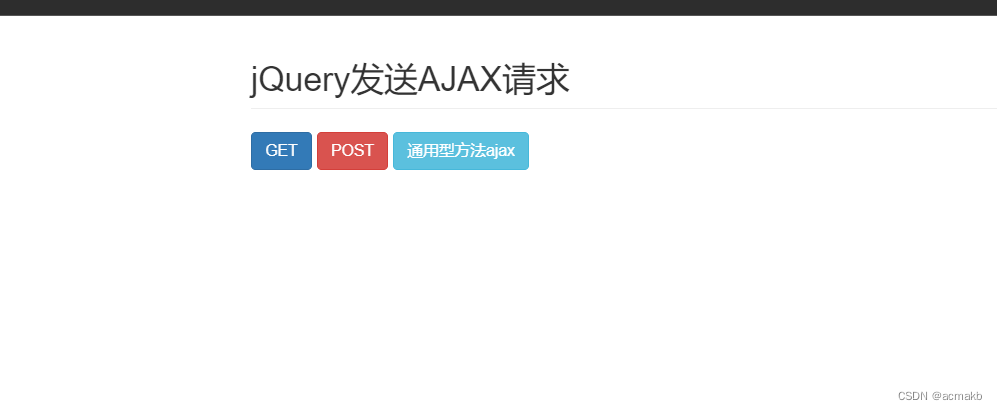
//jQuery 服务
app.all('/jquery-server', (request, response) => {//设置响应头 设置允许跨域response.setHeader('Access-Control-Allow-Origin', '*');response.setHeader('Access-Control-Allow-Headers', '*');// response.send('Hello jQuery AJAX');const data = { name: '我是帅哥' };response.send(JSON.stringify(data));
});
get:
四个参数 : 请求的url ,发送参数对象,回调函数 ,响应体类型
$('button').eq(0).click(function(){$.get('http://127.0.0.1:8000/jquery-server', {a:100, b:200}, function(data){console.log(data);},'json');});
data 就是响应体,xhr.response
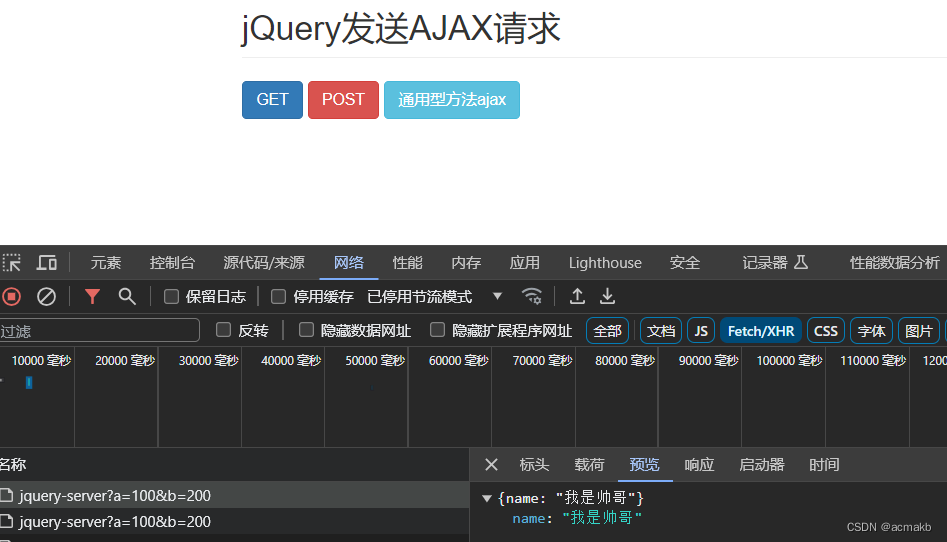
post:
$('button').eq(1).click(function () {$.post('http://127.0.0.1:8000/jquery-server', { a: 100, b: 200 }, function (data) {console.log(data);console.log(typeof data)});});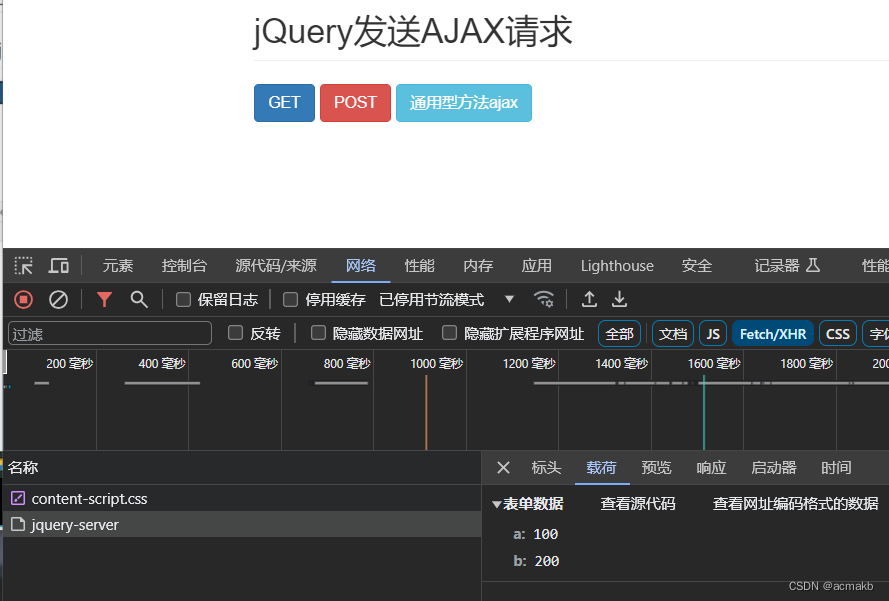

不加上面的第四个参数,返回的就是字符串。
通用写法:
$('button').eq(2).click(function () {$.ajax({//urlurl: 'http://127.0.0.1:8000/jquery-server',//参数data: { a: 100, b: 200 },//请求类型type: 'GET',//响应体结果dataType: 'json',//成功的回调success: function (data) {console.log(data);console.log(typeof data);},//超时时间timeout: 2000,//失败的回调error: function () {console.log('出错啦!!');},//头信息headers: {c: 300,d: 400}});});

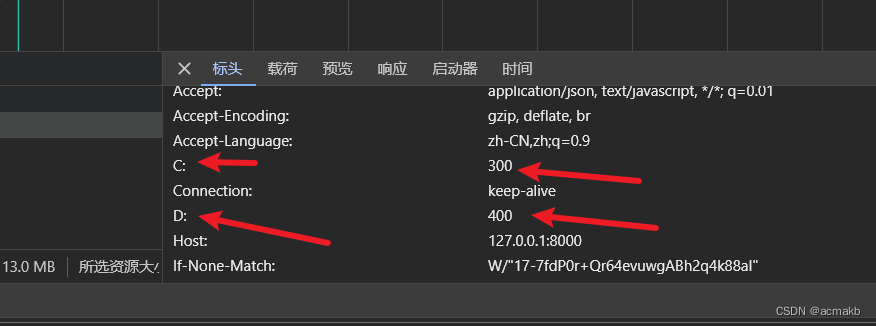
<!DOCTYPE html>
<html lang="en"><head><meta charset="UTF-8"><meta name="viewport" content="width=device-width, initial-scale=1.0"><title>jQuery 发送 AJAX 请求</title><link crossorigin="anonymous" href="https://cdn.bootcss.com/twitter-bootstrap/3.3.7/css/bootstrap.min.css"rel="stylesheet"><script crossorigin="anonymous" src="https://cdn.bootcdn.net/ajax/libs/jquery/3.5.1/jquery.min.js"></script>
</head><body><div class="container"><h2 class="page-header">jQuery发送AJAX请求 </h2><button class="btn btn-primary">GET</button><button class="btn btn-danger">POST</button><button class="btn btn-info">通用型方法ajax</button></div><script>$('button').eq(0).click(function () {$.get('http://127.0.0.1:8000/jquery-server', { a: 100, b: 200 }, function (data) {console.log(data);}, 'json');});$('button').eq(1).click(function () {$.post('http://127.0.0.1:8000/jquery-server', { a: 100, b: 200 }, function (data) {console.log(data);console.log(typeof data)});});$('button').eq(2).click(function () {$.ajax({//urlurl: 'http://127.0.0.1:8000/jquery-server',//参数data: { a: 100, b: 200 },//请求类型type: 'GET',//响应体结果dataType: 'json',//成功的回调success: function (data) {console.log(data);console.log(typeof data);},//超时时间timeout: 2000,//失败的回调error: function () {console.log('出错啦!!');},//头信息headers: {c: 300,d: 400}});});</script>
</body></html>
axios
Axios 是一个基于 Promise 的 JavaScript HTTP 客户端,用于浏览器和 Node.js 环境中发送 HTTP 请求。它提供了一种简洁、直观的方式来执行异步请求,并处理请求和响应的数据。
GitHub地址:https://github.com/axios/axios

get
<!DOCTYPE html>
<html lang="en"><head><meta charset="UTF-8"><meta name="viewport" content="width=device-width, initial-scale=1.0"><title>axios 发送 AJAX请求</title><script crossorigin="anonymous" src="https://cdn.bootcdn.net/ajax/libs/axios/0.19.2/axios.js"></script>
</head>
<body><button>GET</button><button>POST</button><button>AJAX</button><script>const btns = document.querySelectorAll('button');//配置 baseURLaxios.defaults.baseURL = 'http://127.0.0.1:8000';btns[0].onclick = function () {//GET 请求axios.get('/axios-server', {//url 参数params: {id: 100,vip: 7},//请求头信息headers: {name: 'demo',age: 20}}).then(value => { // 基于promiseconsole.log(value);});}</script>
</body></html>
后端服务器:
//axios 服务
app.all('/axios-server', (request, response) => {//设置响应头 设置允许跨域response.setHeader('Access-Control-Allow-Origin', '*');// 运行自定义设置headerresponse.setHeader('Access-Control-Allow-Headers', '*');// response.send('Hello jQuery AJAX');const data = { name: '我是帅哥' };response.send(JSON.stringify(data));
});
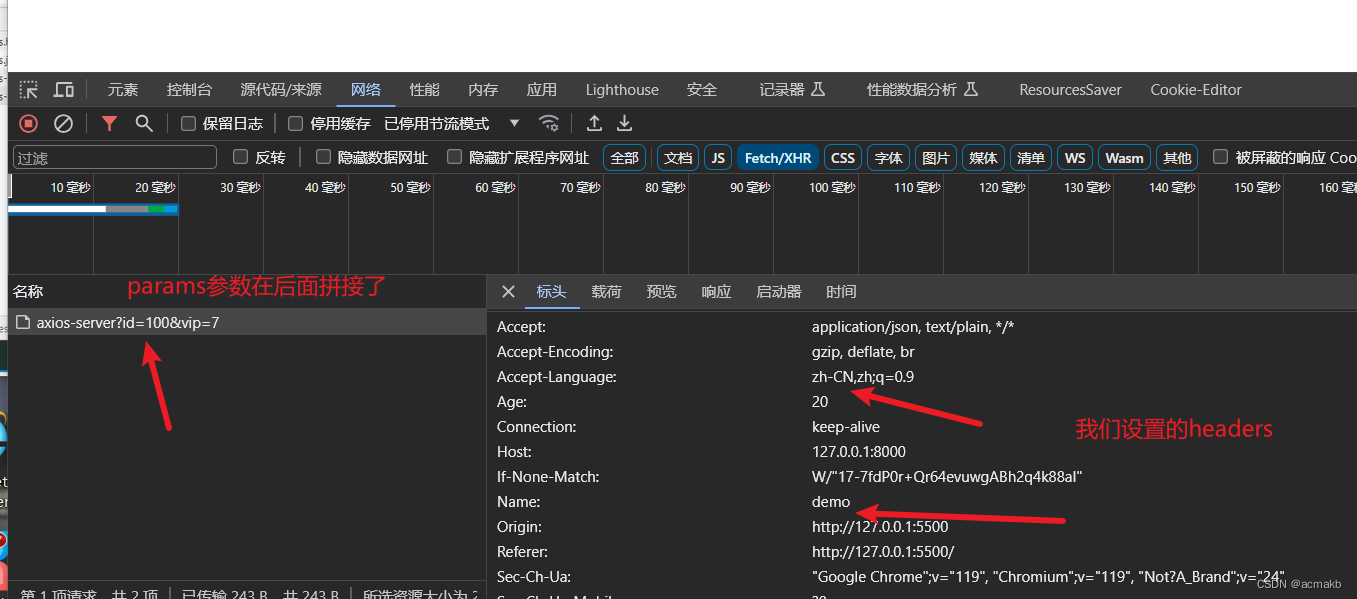
请求得到的响应数据:

post:
btns[1].onclick = function () {axios.post('/axios-server', {username: 'admin',password: 'admin'// 表单数据 }, {//url 路径字符串params: {id: 200,vip: 9},//请求头参数headers: {height: 180,weight: 180,}});}
通用方法:
btns[2].onclick = function(){axios({//请求方法method : 'POST',//urlurl: '/axios-server',//url查询字符串 params: {vip:10,level:30},//请求头信息 headers: {a:100,b:200},//请求载荷数据data: {username: 'admin',password: 'admin'}}).then(response=>{//响应状态码console.log(response.status);//响应状态字符串console.log(response.statusText);//响应头信息console.log(response.headers);//响应体console.log(response.data);})}

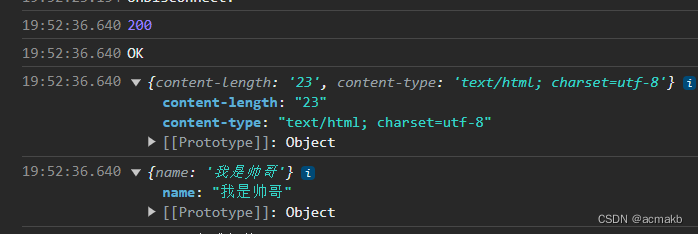
fetch
简介:
fetch 是一个用于发送 HTTP 请求的现代 JavaScript API,内置于浏览器中,可以在前端代码中使用。它提供了一种基于 Promise 的方式来发送和处理网络请求。
post:
<!DOCTYPE html>
<html lang="en">
<head><meta charset="UTF-8"><meta name="viewport" content="width=device-width, initial-scale=1.0"><title>fetch 发送 AJAX请求</title>
</head>
<body><button>AJAX请求</button><script>//文档地址//https://developer.mozilla.org/zh-CN/docs/Web/API/WindowOrWorkerGlobalScope/fetchconst btn = document.querySelector('button');btn.onclick = function(){fetch('http://127.0.0.1:8000/fetch-server?vip=10', {//请求方法method: 'POST',//请求头headers: {name:'atguigu'},//请求体body: 'username=admin&password=admin'}).then(response => {// return response.text();return response.json(); //json对象}).then(response=>{console.log(response);});}</script>
</body>
</html>
//fetch 服务
app.all('/fetch-server', (request, response) => {//设置响应头 设置允许跨域response.setHeader('Access-Control-Allow-Origin', '*');response.setHeader('Access-Control-Allow-Headers', '*');const data = { name: '我是帅哥' };response.send(JSON.stringify(data));
});
